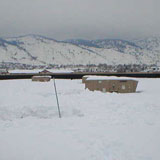Editor's note: This is part one of a two-part series about slip hazards. Part two will appear in the December issue.
When a person is walking and suddenly slips, what does he do? Generally, he tries to make a brisk recovery or at least stand up quickly and brush off before looking around to see whether anyone noticed. Although people usually are embarrassed when they slip, there are reasons (other than clumsiness) for slips. Knowing these reasons can help roofing contractors and their employees avoid what may be slightly embarrassing, as well as painful or even disastrous.
Often, there are no detrimental results for workers or their companies when someone slips. As mentioned, a person hustles to regain his footing, is relieved if no co-workers saw the incident and gets back to work. But a surprising amount of slips result in injuries.
Neil Adams, an ergonomics and safety-management consultant, concludes from his research that 50 percent of falls or near falls that result in injuries are the consequences of slips. Adams also says slips and falls are the third-leading cause of disabling workers in U.S. workplaces. According to the U.S. Bureau of Labor Statistics, more than 22 percent of slips and falls resulted in workers being away from their jobs for more than one month, which can have significant ramifications on any size business.
What is a slip?
A person slips when he loses his balance because there is too little friction between his feet and the walking/working surface. Contributing causes include wet surfaces, spills, weather hazards, walking carelessly and wearing shoes without adequate traction.
In some ways, the human body is always primed for a fall. Slip and Trip Type Falls, a Web document from Nelson & Associates, Bryan, Texas, reminds workers that the body's center of gravity is fairly high off the ground and feet provide a relatively small base of support, making the body a somewhat unstable object in terms of falls.
As a person walks, his center of gravity moves forward and weight and balance are transferred from one foot to the other. People do not think of walking as a complicated process because most people start doing it before they are 1 year old. But in fact, a body's systems constantly are adjusting to coordinate muscular control and balance. The marvel of walking is a complex process even without considering the walking surface.
But roofing workers have to consider their walking surfaces because they contend with a variety of characteristics. Surface friction, texture, slope and protrusions are characteristics anyone walking on a surface must consider. Some common surface hazards for roofing workers include gravel ballast, wet single-ply membranes and sloped surfaces. And there are many individual examples, such as oriented strand board, that can be extremely slippery when wet if they are not installed with the textured side up.
Physics—not chance—govern whether a person slips. Pryme Safety Services Inc., Lodi, N.J., explains how some physics principles work together: friction helps prevent slips; momentum contributes to them; and gravity affects the results.
Friction is the resistance between things, such as between a person's shoes and the surface on which he is standing. With enough friction, there is enough resistance to hold a person's feet in place; without friction, a person may slip. Friction can be measured and is constant between any two surfaces.
Momentum, however, is created by a person's size and speed, and it changes constantly. A worker walking quickly will have more momentum and, therefore, a more dramatic slip than a slower-walking worker. Someone weighing less or walking slower will have a better chance of righting himself before a tumble.
Gravity causes objects (and people) to be pulled toward the center of the earth. If a person's center of gravity is not balanced over his feet or another support, his center of gravity will be pulled toward the ground.
Balancing system
Fortunately, the body has an automatic balancing system. Feedback systems—eyes, ears and muscles—work to keep the body balanced. When these systems are compromised, there is a greater risk of slipping. Visual impairments can be caused by lighting, fog, glares or precipitation; head colds or other inner-ear pressure can affect the ears; and muscles can be thrown off balance when a worker carries too much or reaches beyond his center of gravity.
The best way to avoid slips is to plan ahead. December's column will focus on how to plan for slips.
Amy Staska is NRCA's director of education programs.

